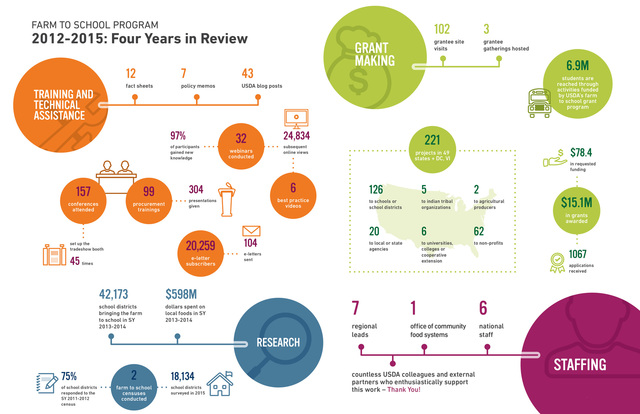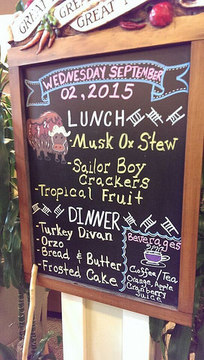Traditional Foods in School Gardens
In celebration of Native
American Heritage Month this November, we bring you this inspiring story about
incorporating traditional food into school gardens and school meals.
Story from Deb Foye
I am
the Nutrition Services Coordinator at Nay Ah Shing School in
Onamia, Minnesota, which is a tribal school. When the gardens were established six years
ago, the Mille Lacs Band’s master gardener supplied us with donated fruit
plants and heirloom rhubarb from his parent's garden. The Band's Department of
Natural Resources helped by providing the materials and manpower to put in the
raised beds. Now we have four 20-foot beds as well as a cucumber tunnel and
sunflower house. We grow several traditional foods, including a “Three Sisters
Gardens,” a Native American tradition of planting corn, squash, and beans
together.
Each spring, each K-5 classroom plants seeds for the garden, then tends the
seedlings, transplanting as needed until it is time to plant in the gardens. When
the seedlings are big enough to be planted in the gardens, each class plants
their vegetables or fruit seedlings. Often, there are enough plants leftover
for the students to each take one home.
During
the summer, the gardens are tended by either staff or student groups. We have
taste testings to incorporate the produce into the summer meals, as well as
into the salad bars when school resumes. We also have started a native garden
which contains sweet grass, tobacco, and sage for ceremonial purposes. This
project has been a very successful adventure, with lots of support from
teachers as well as administration.
Do you have a story to share? We’d love to hear
from you!

 Farm to School at USDA, 2012-2015: Four Years in
Review
What has the USDA Farm to School Program been up to for the
past few years?! A lot!
This recently released report records our major activities from fiscal years
2012-2015 in four different areas: Staffing; Training and Technical Assistance;
Research; and Grant Making. At its inception, the USDA Farm to School Program
focused primarily on incorporating local foods into the National School Lunch
and Breakfast Programs. Four years later, our portfolio is expanding to include
the Summer Food Service Program and Child and Adult Care Food Program and an
emphasis on helping tribal communities incorporate traditional foods into child
nutrition programs. Within USDA’s Food and Nutrition Service, work under this
broader purview will be conducted from a new Office of Community Food Systems.
As we settle into this new office, the timing seems
appropriate to document our early accomplishments and invite feedback from our
colleagues at USDA, other federal partners, and the many external stakeholders
impacted by our work. We welcome your input at farmtoschool@fns.usda.gov.
2016 National Farm to
Cafeteria Conference
Save the date for the 8th National Farm
to Cafeteria Conference June 2-4, 2016 in Madison, Wisconsin. This biennial event, hosted
by the National Farm to School Network, will convene
more than 1,500 people working to source local food for institutional
cafeterias and foster a culture of food and agricultural literacy across
America. Registration will open February 15, 2015 – mark your calendars now!
Do you have expertise to share? The National Farm to School
Network is seeking workshop, poster and lightning talk proposals from
individuals and organizations working to improve our food system, strengthen
community health, empower youth, build equity and increase opportunities for
farmers. The Request for Proposals is open now through December 4, 2015.

Farm to School Census
Deadline Quickly Approaching!
Here is one last reminder to schools districts to edit or
submit responses to the 2015 Farm to School Census survey!! Just follow the
three easy steps outlined on the site to find your district, check your record, and either
update your data or make a new entry. After the submission period has closed,
we will re-tabulate the numbers and begin releasing final results in early 2016.
Currently, 68% of schools districts have responded,
leaving us just 7 percentage points away from our goal to meet or exceed the
75% response rate record set in 2013. Help us get there!

 USDA Foods Help Nourish a Culture
By Emily Doxtator, WINS Intern, USDA Office of Tribal Relations
USDA celebrates National Native American Heritage Month
in November with a blog series focused on USDA’s support of Tribal
Nations and highlighting a number of our efforts throughout Indian
Country and Alaska.
Traditional foods are of significant value to Native American and
Alaskan Natives today. The same foods that have been used to feed our
ancestors not only feed our bodies, but they feed our spirit. The U.S.
Department of Agriculture (USDA) recognizes this importance and works
diligently to offer program and partnership opportunities that help
enhance traditional food access in Indian Country.
If
your tribal community is looking to donate traditional foods to serve
at food service programs at public or non-profit facilities, the Service
of Traditional Foods in Public Facilities memo provides guidance for
organizations and institutions operating under the USDA Food and
Nutrition Service (FNS) Child Nutrition Programs (CNP). The acceptance
of these donations is largely possible due to changes in the 2014 Farm
Bill that defines traditional foods as including wild game meat, fish,
seafood, marine mammals, plants, and berries.
|
|